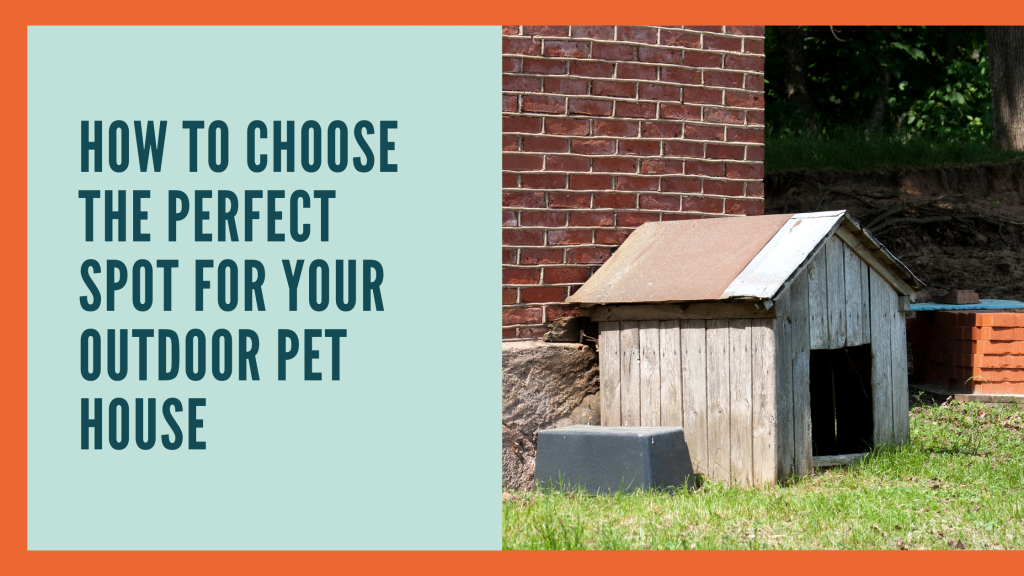Factors to Consider When Choosing a Spot for Your Outdoor Pet House
Choosing the perfect spot for your outdoor pet house is essential to ensuring the comfort and safety of your pet. It’s not just about finding a convenient location; it’s about considering multiple factors to create the best environment for your furry friend. Let’s walk through a few critical points to help you make the right choice.
Accessibility and Convenience
One of the first things to consider when planning for outdoor pet house installation is accessibility. You want to choose a spot that allows you to easily access the house for feeding, cleaning, and spending time with your pet. For instance, imagine you’re bringing in food or toys for your dog, and you’ve chosen a spot in the farthest corner of your yard. This could make daily routines like feeding a bit of a hassle.
Instead, consider a location close to your house or where you typically spend time, like a garden or patio area. This allows you to maintain good visibility and access to your pet house, making maintenance easier. Additionally, choosing a location near a frequently used entrance means less hassle when bringing your pet in and out of their outdoor retreat.
Safety from Potential Hazards
Next, safety is a top priority. You don’t want your pet house installation to be too close to potentially dangerous areas. For instance, avoid placing the pet house next to a busy road or where there might be predators (like hawks, coyotes, or even stray animals) lurking. Imagine your pet’s house located in a corner of the yard where your dog feels safe, only to find that a nearby stray dog is approaching frequently. That would certainly compromise your pet’s well-being.
Instead, choose a more enclosed area of your yard, away from the fence line, busy paths, or areas where hazardous plants or objects are present. Make sure there’s enough space around the pet house for your pet to move freely and comfortably.
Protection from Weather
Weather protection is another major consideration. Whether you live in a region with heavy rain, snow, or scorching sun, your pet’s house needs to be protected from the elements. For example, imagine a pet kennel installation right under a tree. While the tree may provide shade during the summer, the risk of falling branches during a storm could put your pet’s safety in jeopardy.
Instead, pick a spot that offers natural protection from the elements, such as near a tall structure or in the shade of a building. Alternatively, consider positioning the pet house so it faces away from the wind. If you’re in a particularly hot area, the addition of some kind of shade cover can provide extra protection from the sun.
Flat and Stable Ground
To avoid an uneven and uncomfortable living space for your pet, ensure the ground is flat and stable before proceeding with pet house installation. A pet house placed on uneven ground could lead to discomfort or even injury to your pet, especially if the house shifts or tips over.
For example, consider a scenario where you place a wooden pet house design on a sloped area. As the ground shifts over time, your pet’s house may start to lean, making your pet less inclined to use it. This is especially true if the base of the pet house becomes unstable.
Choose a flat and stable location, or use gravel, concrete, or a platform to stabilize the ground beneath the pet house, providing a level foundation for your pet’s comfort and safety.
Privacy and Comfort for Your Pet
Privacy is also key to ensuring that your pet feels secure and comfortable in their outdoor home. Dogs, cats, and other pets may need some alone time, and offering a secluded, peaceful environment will help them feel more at ease. Imagine placing the pet house in a highly trafficked area of your yard, where people are constantly walking by and making noise. This would likely cause your pet stress, particularly if they prefer peace and quiet.
A more secluded spot in the corner of your yard or behind some shrubs can offer the privacy your pet needs while still keeping the house within your line of sight. The goal is to create a space where your pet feels like they have their own little retreat.
Outdoor vs. Indoor Pet House Setup: Key Differences
While many pet owners might opt for an indoor pet house setup, choosing an outdoor pet house installation comes with its own set of considerations. The primary difference lies in the exposure to the elements.
Outdoor pet houses need to be built with more durability in mind. They must be weather-resistant, particularly in areas with extreme conditions like heavy rains, snow, or intense heat. For instance, if you live in an area with harsh winters, an insulated pet house will be essential for keeping your pet warm and comfortable.
In contrast, an indoor setup typically requires less protection from the elements and can focus more on comfort and ease of access. You might prioritize features like cushion pads or a cozy design for an indoor setup. The main point to keep in mind is that outdoor pet houses need additional considerations for weatherproofing and stability.
Designing the Perfect Spot for Pet Comfort
Once you’ve chosen the right spot for your pet house, it’s time to design the space around it to enhance your pet’s comfort and well-being.
Landscaping Around the Pet House
Landscaping can be an excellent way to create a more comfortable and appealing space for your pet. Think about adding some greenery or plants around the pet house. For example, if you’re installing a pet kennel in an open area, you might want to add a few shrubs or a low fence to give your pet a sense of privacy. Additionally, strategically placed trees can offer shade during hot summer months.
Consider also the practicality of your landscape choices. Some plants may be toxic to pets, so be sure to research plants that are safe and non-toxic.
Adding Functional Features
Think about what your pet will need for their comfort. If you’re installing a pet house design for a dog, for example, you might want to add a small water bowl, toys, or even a pet-friendly bed inside the house. You could also create a safe space around the house with gravel or mulch that prevents mud from building up around the entrance.
Also, for pet kennel installation, ensure that you have a secure fencing system in place if needed. This helps prevent your pet from running off and keeps them safe inside their designated space.
Installation Tips for Different Types of Pet Houses
Different pet houses require different installation strategies, so it’s essential to know what type of pet house you’re dealing with before setting it up.
Tips for Wooden and Insulated Pet Houses
When installing a wooden pet house design or an insulated house, it’s important to choose the correct materials and placement. Wood should be treated to withstand weather conditions, and insulated houses need adequate ventilation to prevent moisture buildup.
If you’re installing a wooden pet house, consider raising it off the ground using a platform to avoid water damage during rainy periods. This also improves airflow and prevents pests from nesting beneath the house.
Portable Pet Kennel Installation Tips
For a portable pet kennel installation, ensure that the ground is stable and level before placing the kennel. A portable pet house can move easily, but it still needs a firm foundation to prevent it from shifting during use. Additionally, make sure the structure is easy to assemble and disassemble, allowing you to relocate it quickly if needed.
Common Mistakes to Avoid When Selecting a Spot
There are a few common mistakes that pet owners often make when choosing the location for their pet house:
- Ignoring the climate: Always consider your local climate before deciding on a spot. A sunny location can quickly become too hot for your pet, while an area that doesn’t receive enough airflow can lead to humidity and discomfort.
- Neglecting security: Placing the pet house in an area that’s too exposed to potential dangers—such as traffic or predators—can compromise your pet’s safety.
- Choosing an unstable foundation: Even though a pet house might look good in a particular spot, a sloping or uneven ground can lead to an uncomfortable or even unsafe environment for your pet.
By following these tips and considering your pet’s needs, you can ensure that the chosen spot offers comfort, safety, and convenience. Ultimately, the right spot will keep your pet happy and healthy in their new outdoor home.



